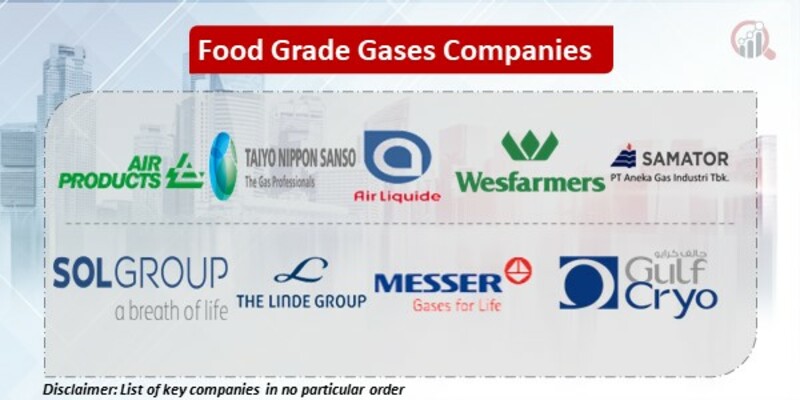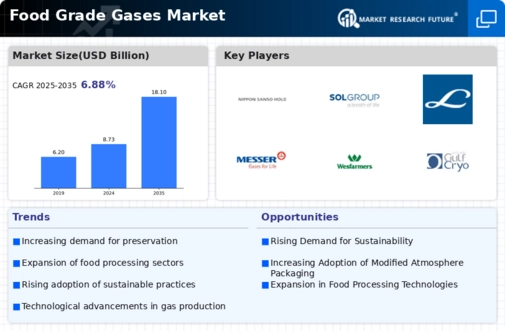Top Industry Leaders in the Food Grade Gases Market
 Beyond the sizzle of steaks and the froth of cappuccinos, a hidden orchestra of gases plays a vital role in the symphony of food processing and preservation. enhance flavor, texture, and safety, ensuring our food delights both palate and health. However, beneath this seemingly simple surface of food-grade gases lies a vibrant competition, where established giants and innovative startups vie for dominance with diverse strategies and evolving trends. Let's delve into the factors shaping market share, industry news, and recent developments that paint a picture of this dynamic landscape.
Beyond the sizzle of steaks and the froth of cappuccinos, a hidden orchestra of gases plays a vital role in the symphony of food processing and preservation. enhance flavor, texture, and safety, ensuring our food delights both palate and health. However, beneath this seemingly simple surface of food-grade gases lies a vibrant competition, where established giants and innovative startups vie for dominance with diverse strategies and evolving trends. Let's delve into the factors shaping market share, industry news, and recent developments that paint a picture of this dynamic landscape.
Key Players and Adopted Strategies:
-
Air Liquide S.A. (France): This multinational gas giant leverages its global reach, extensive production capacity, and brand recognition to secure a significant market share. Their focus on high-purity gases like carbon dioxide and nitrogen, coupled with technical expertise, attracts premium customers in demanding sectors like food processing and beverage production. -
The Linde Group (Germany): Another diversified gas giant, The Linde Group capitalizes on its innovative gas delivery solutions and customized gas blends. Their focus on catering to specific food processing applications and on-site support resonates with diverse food manufacturers. -
Praxair Inc. (USA): A leading industrial gas supplier, Praxair Inc. focuses on cost optimization and bulk production to offer competitive pricing. Their focus on volume deals and partnerships with regional distributors caters to price-sensitive markets and smaller food producers. -
Messer Group (Germany): A leading specialty gases manufacturer, Messer Group emphasizes innovation and niche applications. Their focus on developing new gas mixtures for specific food preservation and flavor enhancement techniques attracts premium customers seeking unique products. -
Taiyo Nippon Sanso Corporation (Japan): This Japanese player leverages its strong presence in Asia and its expertise in cryogenic gases to cater to the growing demand for frozen food preservation. Their focus on energy-efficient gas solutions and sustainability resonates with environmentally conscious consumers.
Factors Shaping Market Share:
-
Rising Demand for Convenience Foods: The growing popularity of packaged and processed foods drives the demand for gases like carbon dioxide for carbonation and nitrogen for packaging. -
Focus on Food Safety and Shelf Life: Increasing awareness of foodborne illnesses pushes manufacturers towards gases like carbon dioxide for inhibiting bacterial growth and nitrogen for modified atmosphere packaging. -
Regional Growth: Expanding into high-growth regions like Asia and Latin America unlocks new customer segments and market potential for food-grade gases. -
Cost Optimization: Efficient gas delivery systems, minimizing gas waste, and offering competitive pricing are crucial for profitability in price-sensitive markets. -
Sustainability: The rising demand for eco-friendly solutions pushes manufacturers towards bio-based gases and responsible production practices.
Key Companies in the Food Grade Gases market include
-
Air Products and Chemicals, Inc (US),
-
TAIYO NIPPON SANSO CORPORATION (JAPAN)
-
SOL Group (Italy)
-
The Linde Group (Ireland)
-
National Gases Ltd (Pakistan) and Praxair Technology
-
Air Liquide (France)
-
Messer Group (Germany)
-
WESFARMERS LIMITED (Australia)
-
Gulf Cryo (Kuwait.)
-
AIR WATER INC (Japan)
-
PT Aneka Gas Industri (Indonesia)
-
The Tyczka Group (Germany)
-
Parker Hannifin Ltd (US)
-
Inc (Kuwait)
Recent Developments:
-
October 2023: A startup unveils a novel portable nitrogen generator for small-scale food producers, offering greater accessibility and flexibility for on-site food processing. -
November 2023: Air Liquide S.A. invests in digital technologies to optimize gas delivery routes and reduce carbon footprint in food processing operations. -
December 2023: The Linde Group and Praxair Inc. partner with leading food research institutions to develop next-generation gas-based sterilization techniques for food packaging, paving the









